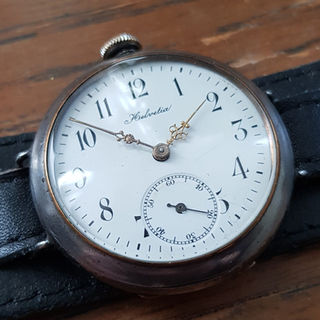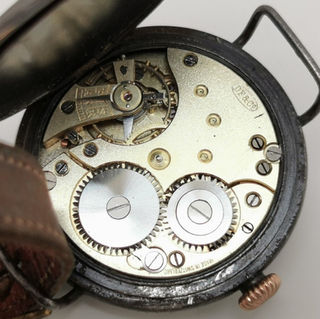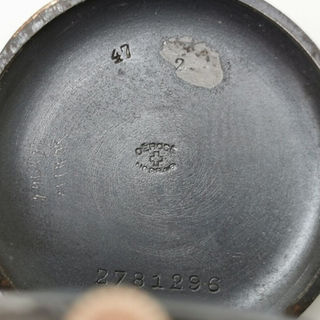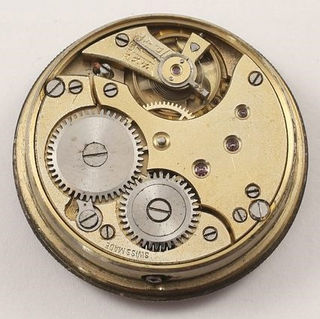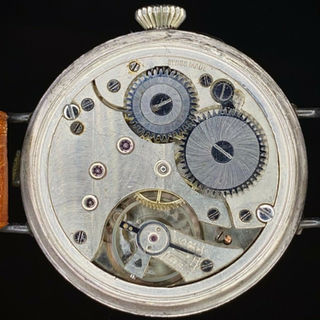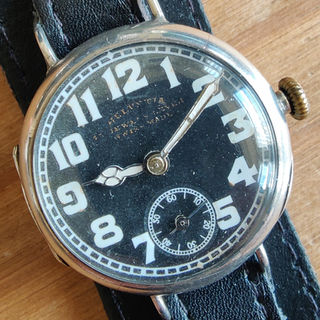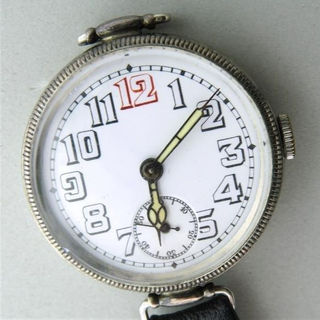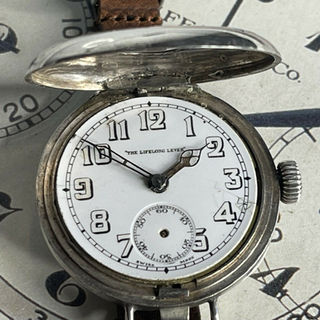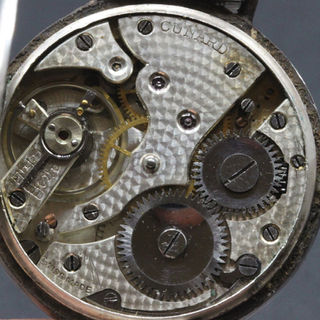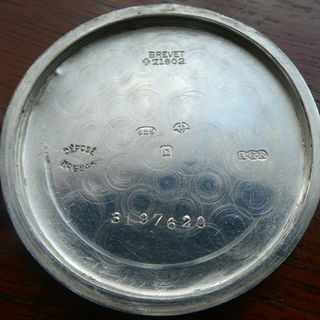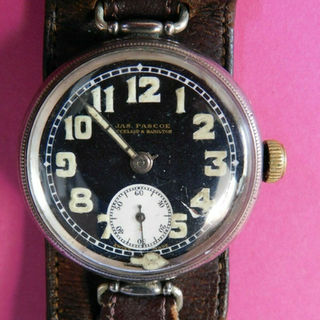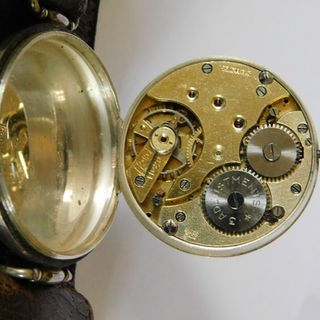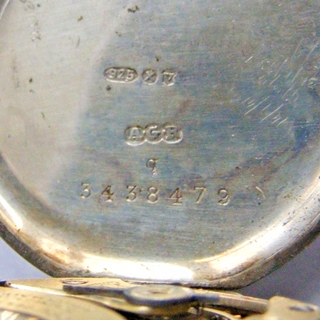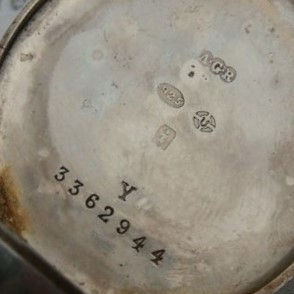
Trench Watches
From the early years of the twentieth century through to the 1920s the General Watch Company produced a range of fixed lug 'Trench' watches under their Helvetia brand name.
Scroll down for more....
Converted Fob Watches
For the first few years after their founding the General Watch Company carried on making the cylinder and lower quality lever watches, mainly under the Gurzelen and Helvetia names, that they had been set up by the Brandt brothers to produce.
However, by about 1904 they had started to manufacture higher quality Helvetia branded watches including some smaller 12 and 13 ligne fob watches. ('Ligne' is a unit of measurement used in watchmaking.)
The 13 ligne movement seems to have been produced by the General Watch Company themselves but the 12 ligne movement was based on a Fabrique d'Horlogerie Fontainemelon (FHF) ébauche or base movement. The watches on this page were mainly sold by the General Watch Company under their Helvetia brand though often these names do not appear anywhere on the watch and the movements are sometimes based on Fabrique d'Horlogerie Fontainemelon (FHF) or Adolf Schild (AS) bases.
1907 Helvetia Advert - 13 Ligne Centre Left - 12 Ligne Centre Right
Some of these small fob watches were later converted to be worn on the wrist, the most likely time for this to have happened is at the start of the First World War when the demand for wristwatches rapidly rose with the greatly expanded armies of the time.
Pre World War One Wristwatches
The General Watch Company had, however, been manufacturing wristwatches for several years prior to the first world war, often for military use where they were more practical than a pocket watch. The earliest Helvetia watch I have seen that seems to have been purpose made as a wristwatch dates to 1908 and is shown below.
This watch is fitted with the 13 ligne Helvetia movement as used in their fob watches. As can be seen the winder of this watch is at the 9 o’clock position rather than the standard 3 o’clock. This placement of the winder is sometimes seen on the earliest wristwatches, in particular early Omega wristwatches. It should not really be a surprise that the General Watch Company also used this layout as both companies were owned by the same family, the Brandts, until 1911. The positioning of the winder at 9 may have been to allow the watch to be worn on the inside of the wrist as in the Omega advert below.

This is another advert from 1910 for the Australian brand 'The Fenchurch Lever', illustrating their wristlet watch with the winder on the left at 9. This brand seems to have exclusively used Helvetia watches so almost certainly this watch is made by Helvetia/General Watch Co .

The movements used in these early wristwatches were lepine movements which had the winder at 12 o’clock and the sub seconds at 6. As can be seen in the preceding adverts when the winder was moved to the 9 o’clock, or more usual 3 o’clock, position the sub seconds dial was often omitted. If not the subdial would appear to the side of the dial instead of at the bottom as was the norm with pocket watches. In this watch however the General Watch Company have decided to create a dial with the sub seconds in this unusual position. Possibly this was to allow those customers who needed a seconds dial to be able to purchase a wristwatch rather than a pocket watch.
In addition to fob watches being converted into wristwatches by local jewellers, as in the examples at the start of this page, some manufacturers converted fob watches they had in storage into wristwatches themselves or used the movements from these lepine fob watches which is why the sub dial is often omitted as mentioned above.
These factory conversions tend to be of better quality than the locally produced ones and it is possible that this watch is one converted from a fob watch by The General Watch Company. You can often tell if a watch was originally created as wristwatch because, in theory, it should have a stamp inside the case back stating ‘Modèle Déposé 9846’ which translates as Registered Design Number 9846. This was a requirement imposed upon the Swiss watch industry by the company Dimier Frères & Cie who had registered the idea of a watch with lugs to take a strap in 1903. Because of this other manufacturers who wished to make wristwatches had to pay Dimier Frères a fee and have their cases stamped as proof. The watch above does not have this stamp but it does have a stamp with ‘Modèle Déposé’ only. Dimier Frères did not start to enforce the requirement for wristwatches to be stamped with their design registration until October 1907 which is around the time this watch was made and it could be that systems were not completely in place and therefore the slightly unusual stamp was used. Of course the stamp could be for a different registered design of the General Watch Company’s but I haven’t been able to find a record of any registered designs by them around this time and no fob or other similar watch of theirs from this time has this stamp. Because of this I believe the stamp was added specifically to do with the fact that the watch is a wristwatch.
Before the surge in demand with the outbreak of the First World War there was no need to convert pocket watches to service the need for wristwatches and with this watch configured with the winder at 9, a layout which had fallen out of favour by then, I lean towards the watch being manufactured in its current form in 1908, using the Helvetia 13 ligne fob watch movement, rather than being converted later.
By 1909 the General Watch Company wristwatches had adopted the more well-known configuration for the winder and sub dial and a watch that makes for a very nice comparison to a Helvetia advert from 1910 is the watch below dating from that same year.
It is fitted with the Helvetia 13 ligne movement and has the Depose No 9846 text stamped in the case lid and as well as UK hallmarks it is marked with the sponsors mark GS for George Stockwell as are almost all UK marked Helvetia watches at this time.
An example of the cheaper, gun metal cased, watches as mentioned in the Fenchurch Lever advert above is next. Interestingly it has what is probably its original strap fitted, stamped with the UK registered design number 405488 as in the text under the Helvetia wristwatch advert shown with it.
World War One
Following the start of the First World War demand for wrist watches grew quickly though it seems that it took a little while for the General Watch Company to ramp up production as it is not until 1915 that there appears to be an increase in the numbers of their wristwatches.
Many of these watches were in Borgel water protected cases. These cases came in two pieces where the movement and bezel screw, as a unit, tightly into the body of the case to make a water resistant seal. The watch shown here is an example of one such watch. The case is marked with the Borgel ‘FB’ makers mark, UK hallmarks and a General Watch Co serial number for 1915. The case also contains the AGR sponsors mark. This is the mark of the importer of the watch, Robert Pringle and Sons, the initials being those of Arthur George Rendell an employee of the company.
Robert Pringle and Sons went on to import General Watch Co/Helvetia watches until well into the 1930s.The movement is the 12 ligne FHF based movement shown at the top of the page.
Below is another example of a very similar Borgel cased Helvetia watch using the same movement. This one is marked with the London retailer Kendal and Dent. At this time, it was usually the case that the watch manufacturer did not mark their watches with their own name.
An interesting watch with the same movement is one that has an engraving on the back of the case to Private Herbert Scott McIntosh who joined the 202nd Battalion, Canadian Expeditionary Force in March 1916.
He arrived in the UK aboard the Mauritania in 1917 and returned to Canada in 1919. The watch is in a clip back case this time, with Swiss silver hallmarks and a Helvetia serial number.
Another of the General Watch Co’s brands at this time was Elsinore and occasionally trench watches appear marked with this brand name. The 13 Ligne Helvetia movement in this watch is branded Elsinore Swiss made.
A more unusual water protected Borgel case is this one which was fitted with an alternate method of setting the hands to the pin set method usually found in Borgel cases.
This method is known as ‘negative set’. The inventors of this method of setting the hands seem to have signed the rights to use it over to the General Watch Co as illustrated by the registered design of 3rd August 1916. This watch is interesting in that it is engraved to the back of the case to Royal Naval Volunteer Reserve signaller LGW Tizard.
Another example of a General Watch Co manufactured watch using this type of setting mechanism is the following watch marked on the dial to the Swiss watch company Favre-Leuba and Co. It also illustrates the fact that Helvetia were supplying watches to other companies. The Helvetia serial number on the Borgel case shows that the watch was supplied as a complete unit to Favre-Leuba.
Later on some General Watch Co watches did start to be marked as such. This 1916 dated watch is marked General W Co Swiss on the case and also at the bottom of the movement, though it is difficult to make out in the photograph.
Along with the many Borgel cased, water protected, watches the General Watch Co produced there were also many ‘hunter’ and ‘half hunter’ watches that were protected by flip up metal covers, sometimes with a see through hole in the middle to still allow the hands to be seen with the cover closed. The Brevet 71363 stamp is reference to a June 1915 patent for the flip up mechanism.
This 1916 dated example is fitted with the 13 ligne movement and has a nice monogram engraved to the outside cover.
Another interesting example of a full hunter Helvetia trench watch is the watch below. The serial number dates the manufacture of the watch to 1917. The cover also bears the inscription - "Presented to Flt. Sergt. J Watson by the Officers of T. Section S. of T.T. Halton Camp 28.1.19" (S. of T.T. stands for School of Technical Training).
And here is an example of a half hunter. The serial number and hallmarks date it to 1918. Interestingly the dial is marked J W Benson, London who were a well known retailer and distributer.
And another, typical of this type manufactured by the General Watch Co. As above with hallmarks and serial number for 1918.
As has already been mentioned manufacturers rarely marked their watches at this time but an interesting early example of this happening is this watch.
It is marked on the dial - 'Helvetia, 15 Jewel Lever, Swiss Made'. The movement is the 12 ligne movement. The silver case bears a General Watch Co serial number which, along with the hallmarks, date the watch to 1917.
A variation of the hunter case was the use of a pierced grill as the flip up lid over the front of the dial to protect the crystal while allowing the time to still be read. These are often called crystal or shrapnel guards though of course they would never be strong enough to stop shrapnel. The design used by the General Watch Co had a shamrock style design in its centre and was built into the case rather than being a separate removable guard. This design carried on in use until about 1930, the later examples having the middle of the design removed to create an uneven hole.
This particular watch is fitted with the Helvetia 13 ligne movement, marked Talis, Swiss Made, which shows this watch is another example of the General Watch Co supplying watches to other manufacturers. The case has hallmarks and a serial number for 1918.
A different way of the General Watch Co attempting to make sure their watches could withstand the rigors of Trench life is illustrated by the watch below.
The Brevet + 71602 on the case back refers to a patent for a case where the bezel screws onto an inner movement ring. This appears to be an attempt at making the case dustproof. Interestingly, although this case was used by several different manufacturers the movement used in the patent drawing is the Helvetia 13 ligne movement. Though the patent dates from 1915 it doesn't look as if Helvetia started using these cases until 1918.
By 1918 it was starting to become common to see General Watch Co watches with other manufacturers or retailers’ details. Here is one in a Borgel case with the famous British maker John Elkan on the dial. I have also seen earlier examples marked John Elkan Colonial that use a negative setting for the hands similar to the negative set Borgel watches already mentioned.
This example is marked ‘The Lifelong Lever’ and the 12 ligne movement is also marked with the ‘3 Adjustments dot, star, dot’ text that appears on the barrel wheel of General Watch Co movements through to the 1930s and is a useful tool to help identify them.
As well as providing complete watches for other distributors and resellers they also provided separate movements for other manufacturers to fit into their own watches. A good example of these are the movements provided to Wilsdorf & Davis (Rolex) for use in their Marconi trench watches. These movements are Helvetia 13 ligne movements but with the plates in a slightly different layout. I have seen this design of movement used in different trench watches, not just Marconi, but they always seem to be in cases with different serial numbers and case markings to the normal Helvetia ones which leads me to believe Helvetia are only supplying the movements not complete watches.
At around this time a new movement starts to appear, it is only occasionally marked but luckily General Watch Co serial numbers also help to give a clue. I believe that this movement may be based on an Adolf Schild (AS) ebauche. The movement on this particular watch is marked Cunard. I have seen the Cunard name used on several General Watch Co manufactured wrist and pocket watches from this period. This watch has a serial number and hallmarks for 1918.
This example is, however, marked General Watch Co on the movement. These movements tend to be in more cheaply made watches and maybe they were a stop gap produced to fill the still great demand, a lot of the time the cases are marked 'Hadorn'. The serial number of this watch dates it to 1919.
Post World War One
Following the end of the war it appears the General Watch Co stopped making its own 13 ligne movements and instead substituted a version of the Adolf Schild 137 (AS 137) movement with the bridges altered to more closely resemble the earlier Helvetia movement. This example dates from 1919 and again carries the ‘3 Adjustments Dot Star Dot’ text on the barrel wheel. This watch also has the patented dustproof case with Brevet + 71602 mark as discussed earlier.
This undated example, but probably from the early 1920s, again using the adapted AS 137 movement, has the same 'Helvetia, 15 Jewel Lever, Swiss Made' text as the 1917 example shown earlier.
The smaller 12 ligne FHF movements along with the new AS based movements continued to be used through the early 1920s. Around 1925 a version of the AS 137 with a slightly different click spring superseded the earlier one. In the watch shown here, with a 1925 serial number, the movement and dial are on a hinge and the movement is accessed by swinging it out of the case, this was another attempt to keep moisture and dust out by not having a separate case back. The dial bears the text "Jas Pascoe, Auckland and Hamilton". Pascoes Jewellers are now a large chain in New Zealand.
And here is the same movement in a 1926 Fenchurch Lever watch fitted with the crystal guard as shown earlier.
An unusual version of an FHF movement seems to have been used in watches the General Watch Co supplied to the Liverpool manufacturer Thomas Russell and Son. This watch has a General Watch Co serial number and silver hallmarks for 1926. This movement is also seen in Thomas Russell and Son watches fitted with General Watch Co early shock protection.
From the mid 1920s a different style FHF movement also replaced that used in the smaller trench watches. The design of this movement had been recorded by the General Watch Co as a registered design, a sort of trademark, as early as 1913. It appears in a Helvetia advert of 1916 in sizes from 8 to 10 lignes and was initially used in some smaller ladies watches. Alongside the larger AS 137 based movements it continued in use until the General Watch Co introduced its new Helvetia calibre 81 movement in 1929.
This example is from 1924 and below is an advert showing different sized variants of this movement with the Helvetia 13 ligne movement (adapted AS 137) together with the General Watch Co’s Orta and Paradox pocket watch movements.
From 1926 these movements started to be fitted with shock protected balances and you can follow the story of the development of Helvetia wristwatches on the Helvetia shock and water protected watch page here.
.
.


